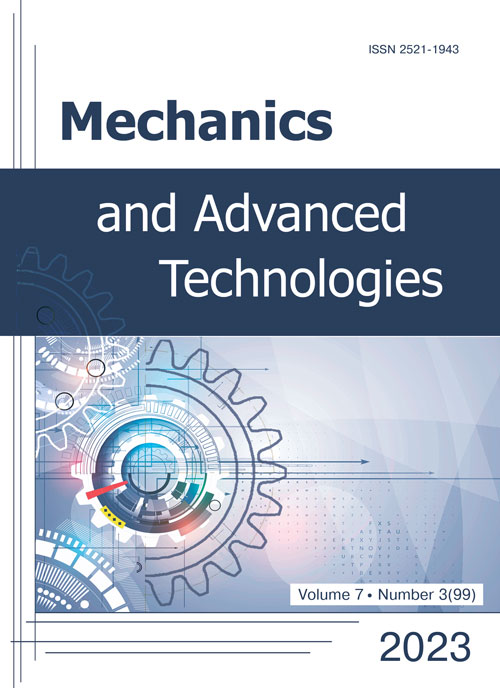The possibility of detecting non-x-ray fragments in the body of the wounded by the contact method
DOI:
https://doi.org/10.20535/2521-1943.2023.7.3.294822Keywords:
special tool diagnostic, noise emission, wound, non-radiocontrast foreign objectAbstract
The types of injuries and types of striking elements were analyzed, the conditions of patients requiring urgent surgical intervention were assessed. The possibilities of existing means of diagnosing fragments in the patient's body were analyzed, and it was concluded that for non-X-ray contrast fragments, the proposed method of mechanical contact with a special flexible and elastic probe is appropriate and effective.
A special tool for examining wound canals has been developed, consisting of a flexible probe for individual use and a handle-holder with a microphone capsule, the membrane of which is directly connected to the probe and reacts to mechanical contact with an obstacle, and the capsule itself is directly connected to the oscilloscope through a signal amplifier . which has spectral signal processing circuits.
The problem of the interaction of the elastic contact of a non-rigid element with a fragment located in a viscous medium is set, provided that the properties of the medium are not constant. Typical solutions of this problem for various types of fragments and parameters of the contacting element itself are presented. A picture of the noise emission accompanying the contact is shown.
The functional dependence of noise emission parameters on the shape and type of the foreign object in the wound canal was revealed. The expediency of using the frequency-amplitude characteristic of noise radiation as a controlled parameter has been proven. A conclusion was made about the functional conditioning of the width of the signal spectrum and basic frequencies at the time of mechanical contact with a foreign object in the wound, depending on its shape and type; it was established that the use of an oscilloscope with a spectral analysis channel allows for the fairly accurate identification of a non-radiocontrast foreign object in a wound.
References
- C. Giannou, M. Baldan and A. Molde, The work of surgeons for the minds of sharing resources during times of violent conflicts and other situations of violence, vol. 2. Geneva, Switzerland: International Committee of the Red Cross, 2013, 634 p.
- Ya. L. Zarutskiy, A. E. Tkachenko and M. S. Vovk, Clinical and epidemiological characteristics of inflammatory chest injuries in military servicemen during the ATO/JFO period. Kyiv, 2021, 93 p.
- I. P. Khomenko, E. M. Khoroshun, V. V. Makarov, V. V. Nehoduiko, S. V. Tertyshnyi, V. P. Maidaniuk and B. Wais, "Choice of the system for evaluating the severity of combat surgical injuries in the wounded with gunshot defects of soft tissues at medical support levels I-II", Hospital surgery, no. 3, pp. 5-12, 2022.
- V. V. Suvorov, “Clinical-pathogenetic basis of methods for assessing the severity of illness in victims of severe trauma in the dynamics of traumatic illness”, Ph.D. dissertation, 2005, 197 p.
- N. V. Tumanska, K. S. Barska and S. V. Skrinchenko, X-ray methods of investigation, Zaporizhzhya: ZDMU, 2016, 82 p.
- M. V. Kononov and S. P. Radchenko, Projective tomography as a physical method of medical diagnostics. Kyiv, 2017.
- I. A. Lurin, V. V. Boyko, K. V. Gumenіuk, P. M. Zamyatin, E. M. Khoroshun, I. F. Mikhailov, O. A. Baturin, V. V. Negoduyko, D. P. Zamiatin and C. M. Tertyshny, "Indicators of X-ray fluorescent intensity in the content of capsules of metal fragiles of soft tissues in injuries with explosive and fire-fire", Emergency medicine, vol. 18, no. 3, pp. 48-54, 2022. DOI: https://doi.org/10.22141/2224-0586.18.3.2022.1491.
- V. A. Stoyan, Modelyuvannya ta іdentifіkatsіya dinamіki sistem іz rozpodіlenimi parametrami. Kyiv: Vidavnicho-polіgrafіchnii tsentr “Kyyivskyy unіversitet”, 2003. 187 p.
- Y. Kerboua, A. A. Lakis, M. Thomas and L. Marcouiller, ”Vibration analysis of rectangular plates coupled with fluid”, Applied Mathematical Modelling, vol. 32, no. 12, pp. 2570–2586, 2008. DOI: https://doi.org/10.1016/j.apm.2007.09.004.
- D. V. Krutchenko, Е. А. Strelnikova and Y. S. Shuvalova, “Discrete Singularities Method in Problems of Seismic and Impulse Impacts on Reservoirs”, Bulletin of V. Karazin Kharkiv National University, vol. 35, no. 1, pp. 31–37, 2017.
- Graham P. Eatwell, “Single-Channel Speech Enchancement”, in Noise Reduction in Speech Applications. Boca Raton: CRC Press, 2002, pp. 155–178. DOI: https://doi.org/10.1201/9781315220109-6.
- F. Gustafsson, Adaptive Filtering and Change Detection. Chichester, England: John Wiley & Sons, 2000, pp. 477–492.
- B. Blagіtko, V. Brigіlevich and І. Yarmolovskiy, “Separation signal from medley signal-noise with using wavelet transform”, Bulletin of Ivan Franko Lviv National University, no. 39, pp. 300–306, 2006. Available: https://physics.lnu.edu.ua/wp-content/uploads/39_44.pdf.
- V. Gnitko, V. Naumenko, L. Rozova and E. Strelnikova, “Multi-domain boundary element method for liquid sloshing analysis of tanks with baffles”, Journal of Basic and Applied Research International, vol. 17, no. 1, pp. 75–87, 2016. Available: https://www.researchgate.net/publication/301655238_Multi-domain_boundary_element_method_for_liquid_sloshing_analysis_of_tanks_with_baffles.
Downloads
Published
How to Cite
Issue
Section
License
Copyright (c) 2023 Олександр Саленко, Юрій Данильченко, Віктор Черняк, Вадим Орел, Валентина Даценко, Богдан Саленко, Костянтин Карпенко

This work is licensed under a Creative Commons Attribution 4.0 International License.
Authors who publish with this journal agree to the following terms:
- Authors retain copyright and grant the journal right of first publication with the work simultaneously licensed under CC BY 4.0 that allows others to share the work with an acknowledgement of the work's authorship and initial publication in this journal.
- Authors are able to enter into separate, additional contractual arrangements for the non-exclusive distribution of the journal's published version of the work (e.g., post it to an institutional repository or publish it in a book), with an acknowledgement of its initial publication in this journal.
- Authors are permitted and encouraged to post their work online (e.g., in institutional repositories or on their website) prior to and during the submission process, as it can lead to productive exchanges, as well as earlier and greater citation of published work











